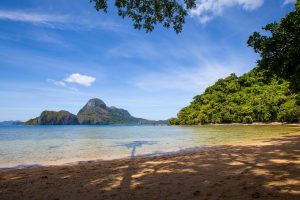In February, residents of Sibuyan Island in the Philippines’ Romblon province protested against a mining exploration activity by forming a “people’s barricade.” This was followed by another barricade in Brooke’s Point in the southern part of Palawan province, which was also organized by community-based groups to protest an ongoing mining operation.
The month of February ended with the sinking of a ship carrying 800,000 liters of industrial fuel that caused a devastating oil spill in Mindoro Island and parts of Western Visayas.
Sibuyan is often described in the news as the “Galapagos of Asia” because of its rich biodiversity. Palawan is known as the country’s last ecological frontier, but years of logging and mining have threatened the island’s endemic flora and fauna. The site of the oil spill in Mindoro has since reached Verde Island Passage, which is regarded as “the center of the center of marine biodiversity” in the world. The oil spill has also gravely affected tourism destinations in Mindoro and the Visayas.
The daring protest of Sibuyan residents forced the mining company to stop its activities on the island. The environment department has subsequently ordered the suspension of the permit for the exploration of nickel ores in Sibuyan.
Opposition Senator Risa Hontiveros supported the Sibuyan residents’ demand to stop mining activities in the critical habitat. “The mountains of Sibuyan and its residents should never be scarred again,” she said in a statement.
The success of the Sibuyan protest inspired residents of Brooke’s Point in Palawan to form a similar barricade against a nickel mining operation. The barricade got the support of environmentalists and the religious sector. Catholic Bishop Socrates Mesiona of Puerto Princesa echoed the sentiment of those who wanted to stop the desecration and plunder of Palawan’s natural resources.
“If the mining company gets away, leaving it to its own devices after being ‘abused,’ we will be left behind and we will be the ones to suffer, not the businessmen, which is the sad reality,” he said in a media interview.
Meanwhile, the oil spill in Mindoro has become the country’s biggest disaster of the year. As of March 19, it had displaced 32,661 families, most of whom are fisherfolk living in coastal barangays (villages). But the total cost of the damage is definitely higher if the destruction of precious coral reefs and other marine life is included. The tragedy is not limited to the oil spill site since the tourism livelihoods in Mindoro and nearby provinces have been disrupted as well.
In response, President Ferdinand Marcos Jr. called for a whole-of-government approach that will involve the mobilization of all agencies to address the emergency situation. Residents have been offered relief packs and temporary jobs during the cleanup operations. Japan and the United States have also dispatched a team of experts to assist the Philippine government in handling the oil spill.
The crisis in Mindoro and the popular local resistance against mining should prompt authorities to review ongoing projects and programs that threaten to further destroy the environment. The pandemic has briefly halted controversial mega projects, but the end of lockdown measures has also led to the resumption of extractive activities and so-called development projects that pose direct harm to local biodiversity. Some projects could even expel indigenous peoples from their ancestral domains like the China-funded Kaliwa Dam in Rizal and Quezon provinces, located near Manila.
Another undertaking that needs monitoring is the building of new military facilities by the United States in at least nine locations, mostly in Luzon, the country’s biggest island. Military exercises between Filipino and American troops will also be held later this month. One of the issues that led to the removal of U.S. troops from the Philippines in 1991 was the reported dumping and contamination of toxic waste inside its military bases. U.S. military ships have also destroyed protected local reefs in the past decade. The environmental impact of the renewed security cooperation between the U.S. and the Philippines is seldom discussed in news and commentaries.
President Marcos called for climate justice when he addressed global leaders in November last year in Cairo. His appeal should embolden his government to pursue policies and programs that will reverse the deterioration of the environment. The first quarter of the year has provided us with a glimpse of key environmental issues and challenges that could potentially spark a broader people’s movement for the protection of the country’s patrimony and precious resources.

































